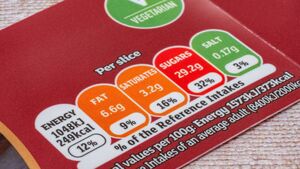Fit Focus: How to read food labels like a pro

A close-up of the nutrition information label on a food products packaging.
WHEN we walk into a grocery store they are dominated by processed and packaged foods, understanding how to read food labels is an essential skill for making informed dietary choices.
Food labels provide critical information about the nutritional content of products, but they can often be confusing or misleading if you don’t know what to look for. By learning how to decode food labels, you can take control of your health, avoid hidden ingredients, and make choices that align with your nutritional goals. Here’s a guide to mastering the art of reading food labels.
The first step in reading a food label is to check the serving size. This information is crucial because all the nutritional values listed on the label are based on this specific amount. Many people overlook this detail and assume that the entire package is one serving, which can lead to overconsumption of calories, sugar, or fat.
For example, a bag of chips might list a serving size as 10 chips, but if you eat the entire bag, you’re consuming multiple servings and significantly more calories than you realize.
Always compare the serving size to how much you actually eat. If you consume double the serving size, you’ll need to double all the nutritional values listed on the label.
Calories provide a measure of how much energy you get from a serving of the food. While calorie needs vary depending on age, gender, activity level, and health goals, understanding the calorie content of a product can help you manage your intake.
For example, a snack with 200 calories per serving might fit into your daily plan, but a 500-calorie dessert might require more careful consideration.
Keep in mind that not all calories are created equal. A 100-calorie pack of cookies is not the same as a 100-calorie apple in terms of nutritional value. Focus on the quality of the calories, not just the quantity.
The next section of the label lists the macronutrients: fats, carbohydrates, and protein. These are the nutrients your body needs in larger amounts for energy and overall function.
Fats: Look for the breakdown of total fat, including saturated and trans fats. Avoid trans fats entirely, as they are linked to heart disease.
Carbohydrates: Pay attention to the total carbohydrates, including fiber and sugars. Fiber is beneficial for digestion and can help you feel full, while added sugars should be limited.
Protein: Protein is essential for muscle repair and overall health. Choose products with higher protein content, especially if you’re looking to build or maintain muscle mass.
The ingredient list is where you’ll find out exactly what’s in your food. Ingredients are listed in descending order by weight, so the first few ingredients make up the majority of the product. Choose products with whole, recognizable ingredients like whole grains, fruits, vegetables, and nuts.
Watch out for hidden sugars, which can appear under names like high-fructose corn syrup, cane sugar, agave nectar, or maltose. Avoid products with long lists of artificial colors, flavors, and preservatives. These additives may have negative health effects over time.
A good rule of thumb is to choose products with shorter ingredient lists and ingredients you can pronounce.
Sodium is a common ingredient in processed foods, and excessive intake can lead to high blood pressure and other health issues. The recommended daily limit for sodium is 2,300 milligrams (about one teaspoon of salt), but many processed foods contain much more. Check the label for sodium content and opt for low-sodium or no-salt-added versions whenever possible.
Food packaging often includes claims like ‘low-fat’, ‘natural’, or ‘gluten-free’ which can be misleading. For example, a product labelled ‘low-fat’ might be high in sugar to compensate for the lack of flavour. Always check the nutrition label and ingredient list to verify these claims.
‘Organic’ means the product meets specific farming and production standards, but it doesn’t necessarily mean it’s healthy.
The term ‘natural’ is not strictly regulated and doesn’t guarantee the product is free from artificial ingredients.
With the term ‘whole grain’, Look for the word ‘whole’ before the grain (e.g., whole wheat) to ensure you’re getting the full nutritional benefits.
Everyone’s nutritional needs are different. If you’re managing a specific health condition, such as diabetes or high blood pressure, focus on the nutrients that matter most to you.
For example, someone with diabetes should pay close attention to total carbohydrates and added sugars, while someone with heart disease should prioritize low sodium and saturated fat.
Reading food labels is a skill that empowers you to make healthier choices and take control of your diet. By understanding serving sizes, calories, macronutrients, and ingredient lists, you can navigate the grocery store with confidence and avoid falling for misleading marketing claims.
Remember, the best foods are often those without labels at all—fresh fruits, vegetables, lean proteins, and whole grains. Use food labels as a tool to complement a balanced, whole-foods-based diet, and you’ll be well on your way to better health.






